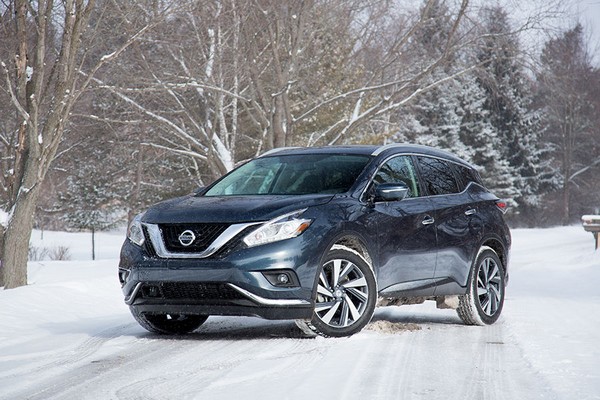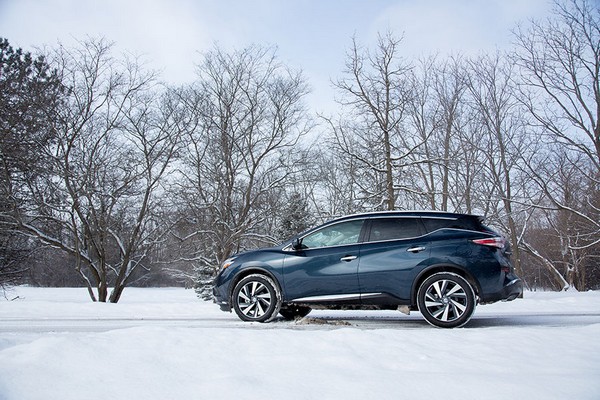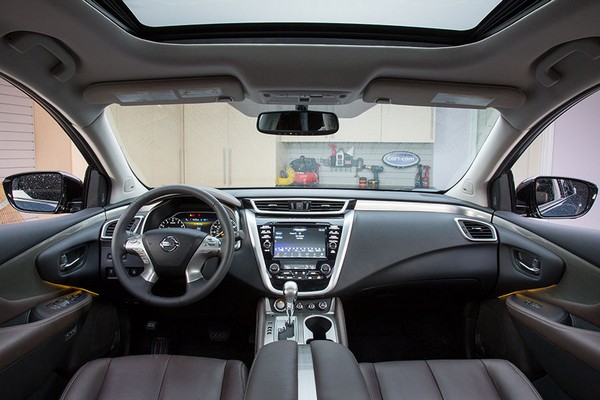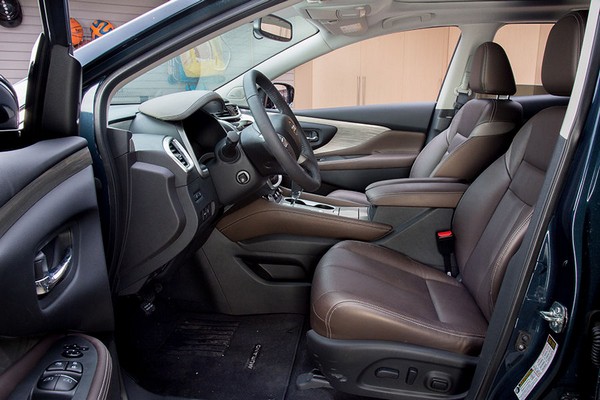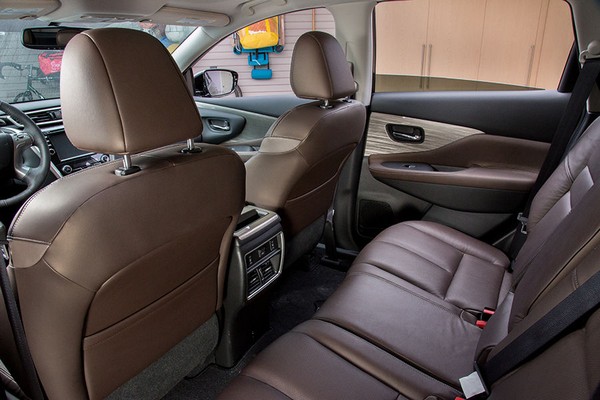What’s New for 2016
A USB port is now standard, and the Bose audio system included in the Premium package now has 11 speakers rather than nine. Otherwise, the Nissan Murano is unchanged for 2016.
Introduction
A crossover SUV is not a vehicle where you’d expect to find bold styling. Typically, these vehicles are more about utilizing vast interior space to carry passengers in comfort, or filling the cargo area to the brim with groceries and the kids’ sports equipment. But the 2016 Nissan Murano is a notable exception. Fully redesigned just last year, the latest Murano has dramatic curves and a sleek roof line that make it a standout in its class. Thankfully, there’s a suitable amount of function to go along with the form, too.
Indeed, passenger space is one of the primary reasons you’d consider buying a Murano. Although the Murano doesn’t offer three rows of seating (as some of its competitors do), there is plenty of space to stretch out, and the seating is impressively comfortable both front and rear. Once seated, you’ll notice how the Murano is noticeably more upscale than the typical compact crossover (think Nissan’s Rogue) thanks to plenty of high-quality materials and standard features. We’re also fond of the powertrain. The Murano has come with a V6 engine paired to a continuously variable transmission (CVT) since its debut all the way back in 2003, and the latest incarnation delivers impressively smooth acceleration and respectable fuel economy.
A few other automakers also offer some models you’ll want to consider, though. The 2016 Ford Edge is a good choice if you want more engaging performance and handling than what the Murano can deliver. For stronger towing performance and off-road ability, the 2016 Jeep Grand Cherokee is ideal. There are also some larger models, such as the 2016 Honda Pilot, 2016 Kia Sorento or 2016 Toyota Highlander, to check out if you think you need more cargo space or a third-row seat to occasionally transport extra passengers. Overall, though, the Murano is a solid choice for an upscale and comfortable crossover that delivers a bit more style than the norm.
Body Styles, Trim Levels, and Options
The 2016 Nissan Murano is a midsize crossover SUV offered in four trim levels: S, SV, SL and Platinum. Each can be had with front- or all-wheel drive.
Standard equipment on the base S includes 18-inch alloy wheels, LED running lights and taillights, automatic headlights, rear privacy glass, a tilt-and-telescoping steering wheel, a 60/40-split folding rear seat, cruise control, dual-zone automatic climate control, Bluetooth phone and audio connectivity, a 7-inch display screen, a rearview camera, smartphone app integration and a six-speaker sound system with a CD player, satellite radio, a USB port and an auxiliary input jack.
The S model is offered with an optional Navigation package that consists of an 8-inch touchscreen, voice recognition, a navigation system, HD radio and an additional USB port.
The SV model gets all the equipment in the Navigation package, plus remote engine start, a leather-wrapped steering wheel, roof rails, foglights, an eight-way power-adjustable driver seat (with power lumbar adjustment) and a four-way power front passenger seat. An optional Premium package for the SV adds a panoramic sunroof and an 11-speaker Bose audio system.
Going with the SL model gets you the Bose audio system as standard and further adds heated outside mirrors, driver memory settings, a blind spot warning system, rear cross-traffic alerts, leather upholstery, heated front seats, an auto-dimming rearview mirror, a 360-degree parking camera system, ambient interior lighting and a power liftgate.
The top-line Murano Platinum is loaded with the above, plus a power tilt-and-telescoping heated steering wheel, 20-inch alloy wheels, LED headlights, additional memory settings, heated and ventilated front seats, heated outboard rear seats and power return rear seats.
The SL and Platinum are offered with a Technology package that includes the panoramic sunroof, adaptive cruise control and a forward collision warning system with automatic emergency braking.
Powertrains and Performance
Powering the 2016 Nissan Murano is a 3.5-liter V6 engine that produces 260 horsepower and 240 pound-feet of torque. A CVT comes standard, and you can get the Murano with either front-wheel drive or all-wheel drive. Either way, EPA-estimated fuel economy stands at 24 mpg combined (21 city/28 highway), which is better than what you get from most competing crossover SUVs with V6 engines.
In acceleration testing of a front-wheel-drive Murano Platinum, Edmunds.com recorded a 7.5-second time to reach 60 mph, That’s about average for a front-drive midsize crossover.
Properly equipped, the 2016 Nissan Murano can only tow up to 1,500 pounds, which is less than the Edge and Grand Cherokee.
Safety
The 2016 Nissan Murano comes standard with antilock brakes, traction and stability control, hill-start assist, front side airbags, side curtain airbags, a driver knee airbag, active front head restraints and a rearview camera.
The SL and Platinum models add blind-spot and rear cross-traffic warning systems, as well as a 360-degree parking camera system that includes a moving-object detection feature that lights up quadrants of the around-view monitor and sounds a beep if people or objects are moving near the vehicle. Optional for these models is adaptive cruise control combined with a frontal-collision warning and mitigation system that can automatically apply the brakes to avoid or mitigate the severity of a frontal crash.
In Edmunds.com testing, a Murano Platinum with front-wheel drive required 117 feet to stop from 60 mph, a shorter than average distance for vehicles in its class.
In government crash tests, last year’s Murano (2015) received a four-star overall rating, with four stars for total front-impact safety and five stars for total side-impact safety. (Updated 2016 front-impact scores were not available as of this writing.) In tests by the Insurance Institute for Highway Safety, the Murano earned a Top score of ‘’Good’’ for its performance in the small- and moderate-overlap frontal-offset impact tests. It also had a “Good” score for side-impact, roof-strength and seat/head restraint (whiplash protection) tests.
Interior Design and Special Features
The seats might not be the first thing you notice when you hop in the Murano, but they will leave a lasting impression. Nissan calls them “Zero Gravity” seats because they are designed to contour to the position the body assumes in zero gravity. Here on 1-G Earth, we think they are among the finest seats on the market. They are especially supportive of the lower and mid back, and you’ll find them up front and in the two outboard rear seating positions.
The rest of the interior is also impressive. While we’re not really sold on the glossy faux wood trim, almost all of the other materials are soft to the touch and high in quality. The overall effect is not unlike stepping into an Infiniti, and the new Murano’s large size gives it an airy feeling. The standard audio system with the 7-inch display screen offers smartphone integration via Facebook, Pandora and iHeartRadio apps. The Nissan Connect 8-inch touchscreen interface houses the available navigation system, but smartphone integration is limited to a Google search application.
When it’s time to haul stuff, the 2016 Murano offers up 32.1 cubic feet of space behind the second row and 67.0 cubic feet with the rear seats folded flat. It’s an adequate amount, and the Murano’s wide stance makes it easy to load up grocery bags and the like. That said, the cargo areas in the Ford Edge and Jeep Grand Cherokee are slightly larger, while rivals with three rows can carry even more.
Driving Impressions
The ride is luxurious in the 2016 Nissan Murano, although the large 20-inch wheels on the Platinum trim make for a choppy experience when driving on poorly maintained roads. While the Murano doesn’t necessarily embarrass itself around turns, body roll is more noticeable and steering responses are slower than in other crossovers. The steering can be oddly slow at times, with no real payoff in terms of feel. Mostly, the Murano is at home just swallowing up miles on the interstate, and we suspect most car buyers will find its laidback personality easy to like.
The V6 engine is suitably powerful and works well with the CVT. While CVTs are often associated with increased engine drone during hard acceleration, this transmission acts more like a regular automatic and simulates gearshifts. That said, accelerating up to highway speeds or passing slower traffic with authority requires an aggressive right foot, and the V6 engine sounds a bit coarse in the process.
Source: Edmunds

